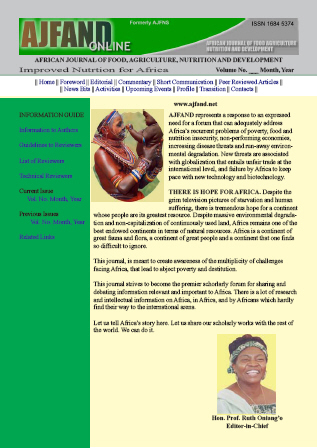
|
African Journal of Food, Agriculture, Nutrition and Development
Rural Outreach Program
ISSN: 1684-5358
EISSN: 1684-5358
Vol. 14, No. 1, 2014, pp. 8428-8444
|
 Bioline Code: nd14001
Bioline Code: nd14001
Full paper language: English
Document type: Review Article
Document available free of charge
|
|
|
African Journal of Food, Agriculture, Nutrition and Development, Vol. 14, No. 1, 2014, pp. 8428-8444
| en |
WHAT CLIMATE CHANGE MEANS FOR FARMERS IN AFRICA: A TRIPTYCH REVIEW MIDDLE PANEL: INTRODUCTIONAL MATTERS AND CONSEQUENCES OF GLOBAL WARMING FOR AFRICAN FARMERS
Stigter, CJ & Ofori, E
Abstract
Climate change seriously influences the livelihoods of African farmers. It was,
therefore, felt useful to make an inventory of what climate change really means for
them. In this review in three parts, climate change is approached by dealing with the
three sides from which the danger comes: (i) global warming, (ii) increasing climate
variability, (iii) more (and possibly more severe) meteorological and climatological
extreme events. These are the three panels of this triptych review. Vulnerable
communities already suffer. They are, therefore, urgently in need of assistance aimed
at building resilience, and at undertaking climate change adaptation efforts to survive
and to maintain their livelihoods. Climate change adaptation projects - especially if
implemented in the context of adaptation strategies at the macro level - often mobilize
public and private stakeholders, engaging them in the problem-solving process.
Scientists have an important role to play in these projects. One of the major problems
in guiding rural change, in a rural response to climate change, is the low formal level
of education that most farmers have and for which governments have done very little
to upgrade it. Improved climate literacy is needed among farmers and a better trained
extension that can guide farmers in further rainfall monitoring and rainfall
interpretation. Further agro-ecosystem observations that, with the rainfall distribution,
explain yields and yield differences are also needed. While it is relatively easy to
define technical messages that can be communicated, one must look beyond
“adaptation to current climate variability“. The basic vulnerability factors of
communities must be targeted. One of the problems faced is that experts on climate
variability and climate change do not really know what information the grassroots
need in the short- and medium-term. However, people assisting vulnerable
communities do not know what science generated products are available and how to
use them. In this first part of the paper, the consequences of global warming are dealt
with at length. Increasing temperatures and changing rainfall patterns get attention
first. Other consequences of increasing atmospheric carbondioxide contents and how
they influence agricultural production in Africa are also discussed. Ten text boxes
distributed over the three parts illustrate local conditions that must be taken into
account to understand the impacts/consequences of climate change for African
farmers and how they may cope with them.
Keywords
African farmers; climate change; vulnerabilities
|
| |
© African Journal of Food, Agriculture, Nutrition and Development
Alternative site location: http://www.ajfand.net/
|
|
